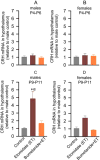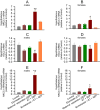Role of environmental stressors in determining the developmental outcome of neonatal anesthesia
- PMID: 28433802
- PMCID: PMC5492971
- DOI: 10.1016/j.psyneuen.2017.04.001
Role of environmental stressors in determining the developmental outcome of neonatal anesthesia
Abstract
Background: The majority of studies evaluating neurocognition in humans who had procedures under anesthesia early in life found long-term deficits even though the typical anesthesia duration normalized to the human life span is much shorter than that shown to induce developmental abnormalities in rodents. Therefore, we studied whether subsequent environmental stressors contribute to deficiencies programmed by a brief neonatal etomidate exposure.
Methods: Postnatal days (P) 4, 5, or 6, Sprague-Dawley rats, pretreated with vehicle or the Na+-K+-2Cl- (NKCC1) inhibitor, bumetanide, received two injections of etomidate resulting in anesthesia for 2h. To simulate stress after anesthesia, the animals were exposed to a single maternal separation for 3h at P10. 3-7days after exposure to etomidate the rats had increased hypothalamic NKCC1 mRNA and corticotropin releasing hormone (CRH) mRNA and decreased K+-2Cl- (KCC2) mRNA levels with greater changes in males. In rats neonatally exposed to both etomidate and maternal separation, these abnormalities persisted into adulthood. These animals also exhibited extended corticosterone responses to restraint stress with increases in total plasma corticosterone more robust in males, as well as behavioral abnormalities. Pretreatment with the NKCC1 inhibitor ameliorated most of these effects.
Conclusions: Post-anesthesia stressors may exacerbate/unmask neurodevelopmental abnormalities even after a relatively short anesthetic with etomidate, leading to dysregulated stress response systems and neurobehavioral deficiencies in adulthood. Amelioration by bumetanide suggests a mechanistic role for etomidate-enhanced gamma-aminobutyric acid type A receptor-mediated depolarization in initiating long-lasting alterations in gene expression that are further potentiated by subsequent maternal separation.
Keywords: Behavior; Developing brain; Environmental factor; Etomidate; Maternal separation; Stress.
Copyright © 2017 Elsevier Ltd. All rights reserved.
Figures






Similar articles
-
Subsequent maternal separation exacerbates neurobehavioral abnormalities in rats neonatally exposed to sevoflurane anesthesia.Neurosci Lett. 2017 Nov 20;661:137-142. doi: 10.1016/j.neulet.2017.09.063. Epub 2017 Oct 2. Neurosci Lett. 2017. PMID: 28982596 Free PMC article.
-
Effects of combined brief etomidate anesthesia and postnatal stress on amygdala expression of Cl- cotransporters and corticotropin-releasing hormone and alcohol intake in adult rats.Neurosci Lett. 2018 Oct 15;685:83-89. doi: 10.1016/j.neulet.2018.08.019. Epub 2018 Aug 17. Neurosci Lett. 2018. PMID: 30125644 Free PMC article.
-
Anesthesia with sevoflurane in neonatal rats: Developmental neuroendocrine abnormalities and alleviating effects of the corticosteroid and Cl(-) importer antagonists.Psychoneuroendocrinology. 2015 Oct;60:173-81. doi: 10.1016/j.psyneuen.2015.06.016. Epub 2015 Jun 25. Psychoneuroendocrinology. 2015. PMID: 26150359 Free PMC article.
-
The bumetanide-sensitive Na-K-2Cl cotransporter NKCC1 as a potential target of a novel mechanism-based treatment strategy for neonatal seizures.Neurosurg Focus. 2008 Sep;25(3):E22. doi: 10.3171/FOC/2008/25/9/E22. Neurosurg Focus. 2008. PMID: 18759624 Review.
-
Neonatal anesthesia and dysregulation of the epigenome†.Biol Reprod. 2021 Sep 14;105(3):720-734. doi: 10.1093/biolre/ioab136. Biol Reprod. 2021. PMID: 34258621 Free PMC article. Review.
Cited by
-
Roles of Testosterone and Estradiol in Mediation of Acute Neuroendocrine and Electroencephalographic Effects of Sevoflurane During the Sensitive Period in Rats.Front Endocrinol (Lausanne). 2020 Sep 30;11:545973. doi: 10.3389/fendo.2020.545973. eCollection 2020. Front Endocrinol (Lausanne). 2020. PMID: 33101193 Free PMC article.
-
Intergenerational Perioperative Neurocognitive Disorder.Biology (Basel). 2023 Apr 7;12(4):567. doi: 10.3390/biology12040567. Biology (Basel). 2023. PMID: 37106766 Free PMC article. Review.
-
Subsequent maternal separation exacerbates neurobehavioral abnormalities in rats neonatally exposed to sevoflurane anesthesia.Neurosci Lett. 2017 Nov 20;661:137-142. doi: 10.1016/j.neulet.2017.09.063. Epub 2017 Oct 2. Neurosci Lett. 2017. PMID: 28982596 Free PMC article.
-
Dexmedetomidine Diminishes, but Does Not Prevent, Developmental Effects of Sevoflurane in Neonatal Rats.Anesth Analg. 2022 Oct 1;135(4):877-887. doi: 10.1213/ANE.0000000000006125. Epub 2022 Jun 21. Anesth Analg. 2022. PMID: 35759382 Free PMC article.
-
A Methyltransferase Inhibitor (Decitabine) Alleviates Intergenerational Effects of Paternal Neonatal Exposure to Anesthesia With Sevoflurane.Anesth Analg. 2020 Oct;131(4):1291-1299. doi: 10.1213/ANE.0000000000005097. Anesth Analg. 2020. PMID: 32925350 Free PMC article.
References
MeSH terms
Substances
Grants and funding
LinkOut - more resources
Full Text Sources
Other Literature Sources
Medical

